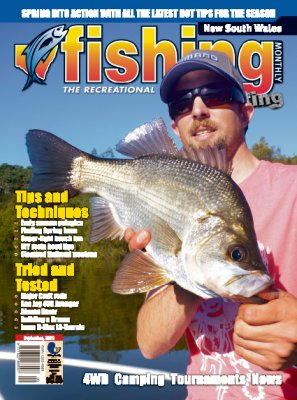Finding Spring bass by Roderick Walmsley
 We had covered a fair bit of ground with only one small bass to show for our efforts. It was the start of the open season for wild bass and we were keen to catch a few to get the season rolling.
We had covered a fair bit of ground with only one small bass to show for our efforts. It was the start of the open season for wild bass and we were keen to catch a few to get the season rolling.
I was casting a spinnerbait, while my mate was throwing a topwater.
We were fishing quite quickly, covering ground to try to find the fish.
The electric motor was working hard as we rounded a bend in the river, the bottom shelving down a bit and then dropping away, and my attention was starting to focus on my sounder.
So when the hit came I wasn't really expecting it.
There is just something about a bass hitting a spinnerbait that makes you want to keep casting these lures. The rod was wrenched sideways and as I leaned back, the drag gave up a bit of line as the fish tried to turn and head back to where it had made its ambush.
The fight was spirited but short-lived and I slipped the net under the fish and lifted it into the boat.
It was a good bass of around 38cm and in excellent condition. I unhooked it and as I was releasing the fish, noticed others marking up on my sounder.
After several unsuccessful casts at the bank, we altered our approached and started to target the fish holding deep.
It was the start of a great little session in which we caught bass at regular intervals on a variety of lures. This is what Springtime bassing is all about.
COVER GROUND
In small river systems and medium-sized dams, bass can be fairly predictable, frequenting the same places year in and year out.
This can also be the case on our larger systems. The difference, however, is that the fish can move through these areas and how long they stay there can depend on a lot of things.
Often the key to finding these fish in the Spring is to cover a lot of water.
You need to fish fast but still effectively.
This sounds a like a bit of a paradox but it is possible to cover water quickly if you use the right lures that can be fished fast, yet effectively in and around cover.
Lures like spinnerbaits, crankbaits and even to a degree topwaters are good choices to start off with while you are covering ground trying to locate the fish.
You need to remember that the key at this stage is to find concentrations of bass and not necessarily to catch them.
Instead, you need to be moving along through an area that you are confident in yet not get stuck for too long trying for fish.
If you get a hit or raise a fish on the topwater, then you can start to slow down and really pick apart the bankside structure with a variety of lures
LURE CHOICE
When selecting a spinnerbait, try to choose a heavier model, like a 1/2oz version, and if necessary downsize the blades and even look at using tandem willow leaf blades, as opposed to a single Colorado.
This will allow the lure to sink faster and you can retrieve it a bit quicker, yet it still stays relatively deep in the water column.
This way your lure will spend more time in the strike zone and give the bass that little bit of extra time to commit to grabbing your fast-moving lure.
Remember that by now the water temperature would have started to increase and the bass should in essence be more active. If you put your lure in the right places, they should eat it.
Crankbaits can also be worked along the bank quite quickly, with the deeper models the pick early in the season. These will crash dive straight into the strike zone instead of taking a few feet, or even metres, to attract the fish's attention.